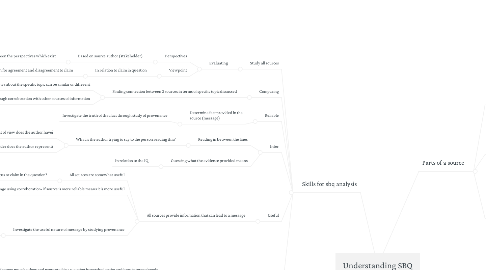
1. Skills for sbq analysis
1.1. Study all sources
1.1.1. Evaluating
1.1.1.1. Perspectives
1.1.1.1.1. Based on source author (stakeholder)
1.1.1.2. Viewpoint
1.1.1.2.1. In relation to claim in question
1.2. Comparing
1.2.1. Finding connection between 2 sources in terms of specific topic discussed
1.2.1.1. Views about the specific topic can be similar or different
1.2.1.1.1. Can be connected to the idea that different stakeholders have different point of view
1.2.1.2. Investigate the truth of that fact through corroboration with other sources of information
1.3. Reliable
1.3.1. Determine fact provided in the source (message)
1.3.1.1. Investigate the truth of that fact through study of provenance
1.4. Infer
1.4.1. Reading in between the lines
1.4.1.1. What is the author trying to say to the person reading this?
1.4.1.1.1. What point of view does the author have?
1.4.1.1.2. Which stakeholder does the author represent?
1.4.2. Guessing what the evidence provided means
1.4.2.1. In relation to the IQ
1.5. Useful
1.5.1. All sources provide information that can lead to a message
1.5.1.1. All sources are somewhat useful
1.5.1.1.1. Is there a focus or claim in the question?
1.5.1.2. Investigate the truth of message using corroboration- if source is more reliable means it is more useful
1.5.1.2.1. This is only one way to assess whether an information is useful because something that is unreliable can be concluded as being less useful
1.5.1.3. Investigate the useful nature of message by studying provenance
1.5.1.3.1. Does this useful information represent a specific perspective of a specific stakeholder?
1.6. Purpose
1.6.1. Intended message delivered by an author/creator of source to convince an audience to take action
1.6.1.1. Message must be clear and presented in a way that is matched to the audience interest/needs
1.6.1.2. Author =stakeholder who wants to influence others to understand and buy into his perspective
1.6.1.3. Action is a direct response of the audience to the author’s message
1.6.1.3.1. Must show change in behaviour (specific action/reaction) rather than just a change of feeling or mindset
1.6.1.4. Audience must be a stakeholder in the issue that the author needs to influence (specific)
2. Parts of an SBCS
2.1. Inquiry Question
2.1.1. Provides the controversy or cause of tension in the case study
2.1.2. Provides a guide of what to look for in each source (the big question)
2.1.2.1. Can guide annotation
2.1.2.1.1. Pick out the 2 sides or more of the controversy which causes tension
2.1.2.1.2. Supporting reasons for controversy
2.2. Background info
2.2.1. Provides details surrounding the issue- can be an event or a response to an event or a human phenomenon (based on concepts learnt on syllabus)
2.2.1.1. Pick out details that are relevant to the event and stakeholders involved
2.3. Sources
2.3.1. Selected as a representation of the various perspectives held by different stakeholders in the issue
2.3.1.1. Successful students of SS are able to connect the sources in a case study to help them understand an issue more deeply
3. Parts of a source
3.1. Explanation
3.1.1. Linking the evidence and message
3.1.2. Clarifies on the message of source (reasoning)
3.2. Provenance
3.2.1. Gives details about the who, what and when of a source
3.2.1.1. Who=individual who has been through the issue
3.2.1.1.1. Ask what the individual wants
3.2.1.2. Who= representative of organisation who is a stakeholder in the issue
3.2.1.2.1. Ask what the organisation wants
3.2.1.3. What= form of source (eg speech)
3.2.1.3.1. Reveals the potential audience and intent
3.2.1.4. When= what is the context in which the source was produced?
3.2.2. Helps to identify source as primary or secondary evidence
3.3. Evidence
3.3.1. Clues within a source
3.3.1.1. Need to narrow down and select
3.3.1.1.1. Selection criteria

